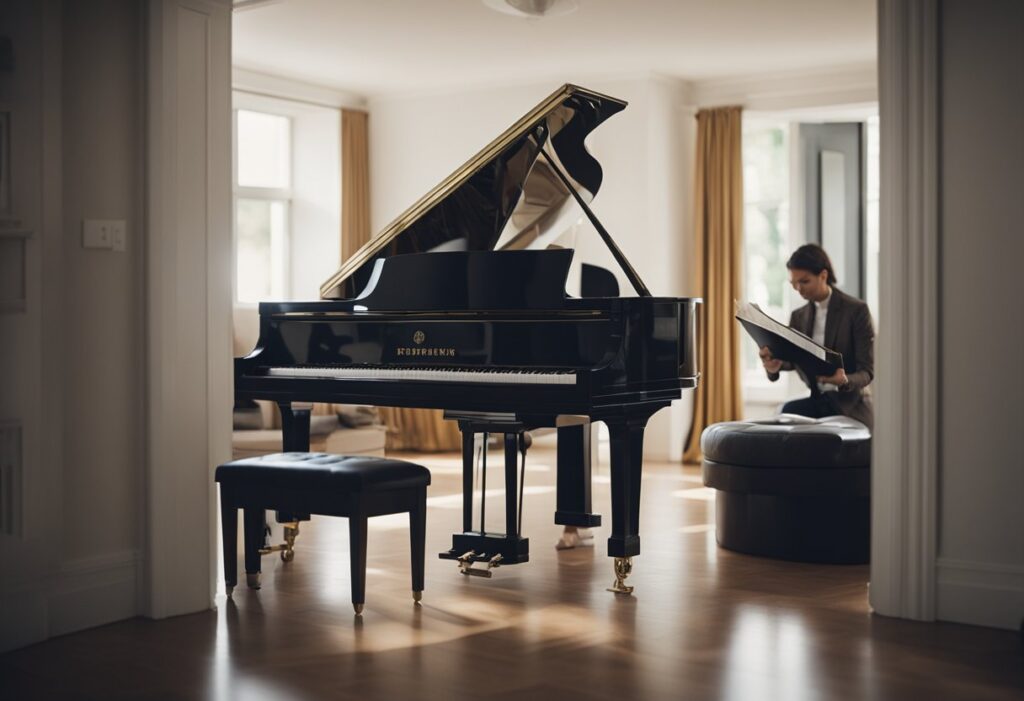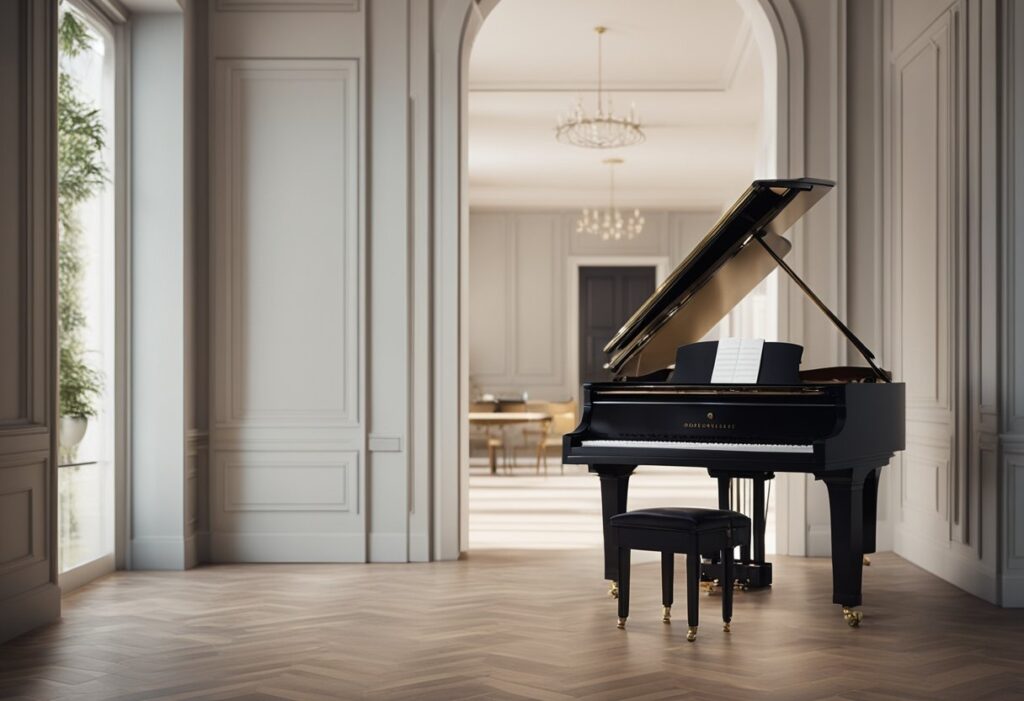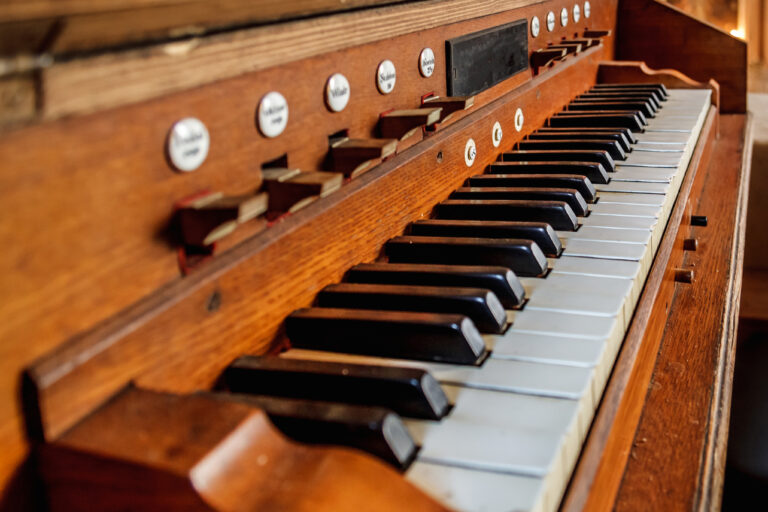Will My Piano Fit Through the Door? Tips and Solutions
If you’re moving to a new home or simply rearranging your furniture, you may be wondering if your piano will fit through the door. It’s a common concern for many piano owners, as pianos are often one of the largest and heaviest items in a home.
The answer to this question depends on a few factors, including the size of your piano, the size of your door, and the layout of your home.

First, it’s important to determine the size of your piano. Pianos come in a variety of sizes, from small spinets to large concert grands. The size of your piano will affect whether or not it will fit through your door.
Additionally, the weight of your piano is also a factor to consider, as heavier pianos may be more difficult to manoeuvre through tight spaces.
The size of your piano will affect whether or not it will fit through your door. Additionally, the weight of your piano is also a factor to consider, as heavier pianos may be more difficult to manoeuvre through tight spaces.
In the next section, we’ll discuss how to measure your piano to determine if it will fit through your door.
Piano Dimensions and Door Measurements

Measuring Your Piano
Before attempting to move your piano through a doorway, it is essential to know its dimensions. Pianos come in different sizes and shapes, and it is crucial to measure your piano accurately to avoid any damage during transport.
To measure your piano, you will need a measuring tape.
Start by measuring the width of the piano at its widest point, which is usually the keyboard.
Next, measure the depth of the piano from the front to the back. Lastly, measure the height of the piano from the floor to the top of the lid.
It is essential to note down these measurements accurately to ensure that your piano fits through the doorway.
Measuring Doorways
Once you have measured your piano, the next step is to measure the doorway through which you plan to move it. Doorways come in different sizes, and it is essential to measure the width, height, and depth of the doorway.
To measure the width of the doorway, measure from one side of the frame to the other.
Next, measure the height of the doorway from the floor to the top of the frame. Lastly, measure the depth of the doorway from the front to the back.
After measuring the piano and doorway, compare the measurements to determine if the piano will fit through the doorway. If the piano is too large, you may need to remove the legs or disassemble it before moving it through the doorway.
Moving Techniques and Equipment

Lifting Strategies
When moving a piano, it is essential to use proper lifting techniques to avoid injury and prevent damage to the instrument.
You should always lift with your legs, not your back, and keep your back straight. It is also important to have a firm grip on the piano and to avoid twisting your body while lifting.
To make the lifting process easier, consider enlisting the help of a few friends or hiring professional movers. This will ensure that there are enough people to safely lift and move the piano.
Required Moving Equipment
Moving a piano also requires specific equipment to ensure that it is transported safely. Here are some of the necessary items:
- Piano dolly: A piano dolly is a specialized dolly designed to transport pianos. It has four wheels and is made of sturdy materials to support the weight of the piano.
- Moving straps: Moving straps are used to secure the piano to the dolly and prevent it from shifting during transport.
- Furniture blankets: Furniture blankets are used to protect the piano from scratches and other damage during the move.
- Ramp: A ramp is necessary to load the piano onto the dolly and into the moving truck.
Make sure to have all of these items before attempting to move your piano. It is also important to ensure that the equipment is in good condition and functioning properly to avoid any accidents during the move.

When it comes to moving a piano through a doorway, there are a few things to keep in mind to ensure a smooth and successful transition. Here are some tips for navigating through the door.
Assessing the Pathway
Before attempting to move the piano through the door, you’ll need to assess the pathway.
Measure the width of the doorway and compare it to the width of the piano. If the piano is wider than the doorway, you’ll need to remove the door from its hinges or disassemble the piano to make it smaller.
You’ll also want to clear the pathway of any obstacles, such as furniture or rugs, that could get in the way. Make sure the pathway is wide enough to accommodate the piano and any helpers who will be assisting with the move.
Angle and Rotation Techniques
Once you’ve cleared the pathway and assessed the doorway, it’s time to start moving the piano.
One technique to use is to angle the piano so that it’s diagonal to the doorway. This can make it easier to manoeuvre the piano through the doorway. Be sure to lift with your legs, not your back, to avoid injury.
Another technique is to rotate the piano as you move it through the doorway.
This can be done by having one person hold onto the front of the piano while another person holds onto the back.
Slowly rotate the piano as you move it through the doorway, being careful not to scratch the walls or damage the piano.
Potential Obstacles and Solutions
Disassembling the Piano
If your piano is too large to fit through the door, you may need to disassemble it. This can be a daunting task, but it is often the only solution.
Before you begin, make sure you have the proper tools and a clear understanding of how to take your piano apart.
One option is to remove the legs and pedals. This can reduce the height of the piano and make it easier to fit through the door.
Another option is to remove the keyboard. This can be more complex, but it can greatly reduce the width of the piano.
When disassembling your piano, be sure to label all the parts and keep track of the screws and bolts. This will make it easier to put the piano back together later.
If you are unsure about how to disassemble your piano, it may be best to hire a professional.
Removing Door Hinges
Another potential obstacle is the door frame itself. If the door is too narrow, you may need to remove the hinges to create more space.
To do this, you will need a screwdriver and a helper to hold the door in place.
First, remove the screws from the top hinge. Then, have your helper hold the door while you remove the screws from the bottom hinge.
Carefully remove the door from the frame and set it aside. This will give you more room to manoeuvre the piano through the doorway.
Once the piano is safely inside, you can reattach the door by following the same steps in reverse.
It is important to make sure the door is level and secure before reattaching the hinges.
Professional Moving Services
Moving a piano is a challenging task that requires expertise and experience. If you’re not confident in your ability to move your piano through a door, you may want to consider hiring professional movers.
Hiring Professional Movers
Professional movers have the necessary equipment, expertise, and experience to move your piano safely and efficiently.
They can assess your piano’s size, weight, and shape to determine the best way to move it through the door.
They will also have the necessary tools and equipment, such as dollies, straps, and padding, to protect your piano from damage during the move.
When hiring professional movers, be sure to choose a reputable company with experience in moving pianos.
Look for reviews and ratings from previous customers, and ask for references. You may also want to verify that the company is licensed and insured.
Costs and Insurance
The cost of hiring professional movers to move your piano will depend on several factors, including the distance of the move, the size and weight of your piano, and any additional services you may require, such as packing and unpacking.
Be sure to get a written estimate from the moving company before hiring them, and ask about any additional fees or charges.
It’s also important to consider insurance when hiring professional movers.
Most moving companies will offer some form of insurance to protect your piano during the move.
However, it’s important to read the fine print and understand what is covered and what is not. You may also want to consider purchasing additional insurance to provide extra protection for your piano.
Frequently Asked Questions
What are the typical dimensions of an upright piano for moving purposes?
For moving purposes, an upright piano typically measures around 58 inches wide, 25 inches deep, and 48 inches tall. However, the dimensions can vary depending on the specific make and model of the piano.
It’s important to measure your piano before attempting to move it to ensure that it will fit through doorways and other narrow spaces.
How can you measure your doorway to ensure a baby grand piano will fit through?
To measure your doorway, you’ll need to measure the width and height of the opening. Make sure to measure the narrowest point of the doorway to ensure that the piano will fit through.
A baby grand piano typically measures around 5 feet wide and 4 feet deep, so you’ll need to make sure that there is enough clearance to move the piano through the doorway.
What is the standard procedure for moving a piano through a narrow space?
When moving a piano through a narrow space, it’s important to take your time and be careful.
The piano should be wrapped in blankets or moving pads to protect it from damage. The piano should also be positioned on a dolly or other moving equipment to make it easier to move.
If the space is too narrow, the piano may need to be dismantled and reassembled after the move.
Are professional piano movers necessary for transporting large pianos?
Transporting large pianos can be a difficult and dangerous task, so it’s often best to hire professional piano movers.
Professional movers have the experience and equipment needed to move pianos safely and efficiently. They can also provide insurance to protect your piano in the event of damage during the move.
What precautions should be taken when dismantling a piano for a move?
Dismantling a piano for a move should only be done by a professional piano technician.
The technician will know how to safely and properly dismantle the piano without causing damage. The piano should be carefully labeled and all parts should be stored safely to prevent damage during transport.
How much clearance is needed when positioning a piano in a room?
When positioning a piano in a room, you’ll need to make sure that there is enough clearance around the piano.
A grand piano typically requires a space of at least 5 feet by 8 feet, while an upright piano requires a space of at least 5 feet by 4 feet.
Make sure to measure the space before moving the piano to ensure that it will fit comfortably.






